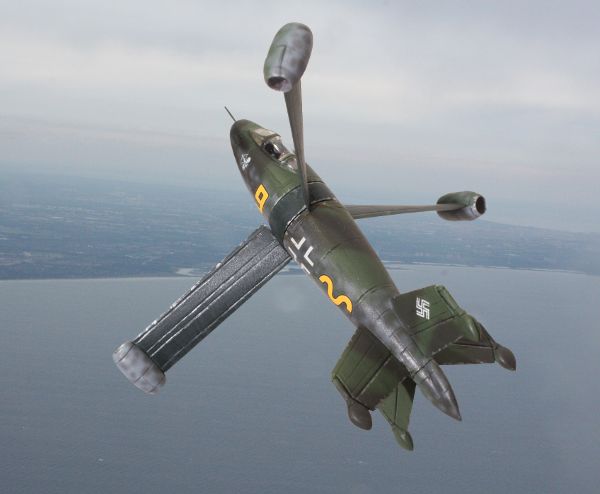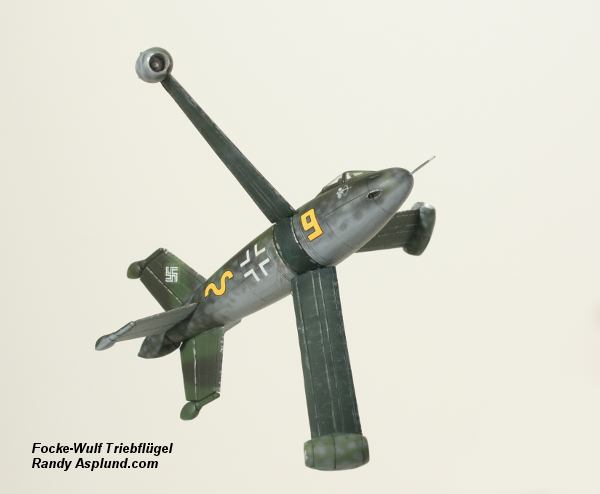
Focke-Wulf Fw Triebflügel
by
© Randy Asplund
|
The large bulge in the tail and the four smaller ones in the tips of the fins contained the landing gear, and the rotors would be turned to work like a helecopter for take-off and landing. The concept was explored in the 1950s by the US. The obvious weakness is that there is not a good way for the pilot to judge direction or distance to the ground on the landing. The other weirdness is that it runs on three jet engines, each one at the tip of a rotor blade. Although they would be moving fast, it seems to me that this would increase the frontal target area and make it easier to hit by a defending bomber. I just wonder how many hits to a rotor it would take to weaken it to failure. And since the fuel likes run through there, imagine the effects of an engine cutting out and leaving the whole unbalanced! The Huma model has recessed panel lines, but I also consider it to be a lazily crafted kit. Fortunately, the rotor ring works smoothly, because that was the most likely place the maker could have ruined the kit. But the fit there is quite good. The fit everywhere else is lacking. I cut off the landing gear on the fin tips and cemented the doors in a closed position, but even with care the parts did not fit very well. And for some reason the maker didn't bother to put locator pins on the fuselage halves. The rotors attach to the ring with small points, and they are fragile, but they will be just strong enough if it is handled with care. Be careful not to use too much cement there. The cockpit has a good and a bad side. On the good side you get a floor, a joy-stick, a nice looking seat, and even a console with a decal for the gages! But wow, what a terrible sculpting job they did on the pilot. He looks like he was made from wax and left to close to the stove. Worse, all of that wonderful stuff you get in the cockpit is wasted because the hole for the top of the cockpit is barely bigger than the pilot himself! It is all hidden, and if positioning isn't your fotree, whoops! There are no locator pins; just a couple of anbiguous bars. I ended up cutting the opening to the cockpit bigger so I could move the control panel forward and get it in front of the stick. Yeah, they had it between the stick and the pilot. How lame! Decals: You want Decals? These were not designed with much thought about what it would have been like, and the color scheme was just an RLM 74 Grey mottled over RLM 75 grey. Not very inspired. Nor do you get any kind of unit markings. At a time when you might expect colored "Defence of the Reich" bands, why skimp? You get 4 swastikas made of dots, and they want them to go on both upper AND lower vertical stabilizers. Of course they won't tell you that because they don't mention the swastikas anywhere in the instructions. Your other decals are the two side crosses, an identical superfluous pair of white side crosses, and a V number, which shouldn't be on operational fighters and is not in ther instructions either. Yet the decal sheet does identifiy itself as being for this model. As you see, I painted it very differently. I was working on the Do 335 model at the same time, and conveniently, it also had a cruciform tail. By looking at the Do 335 as a precedent, there is upper surface camouflage on the lower vertical stabilizer, and no swastikas there. I also decided to go with the same camouflage coloration of my Do 335, using RLM 81 Olivbraun/ 82 Hellgrun/ 65 Hellblau (post 1941). I used a splinter pattern on what the upper surfaces would be while in flight, but then I used RLM 75 Mittelgrau mottling along the sides to blend where the top met the sky color underneath. The other thing I did was to make a decision about the rotors based on RLM standards for propellers, which are always supposed to be RLM 70 Schwarzgrun. The jet enjones count as fuselage devices, so I painted them as the fuselage. I hand painted a little skelleton archer on both sides of the nose and added aircraft number 9, Gruppe IV.  |